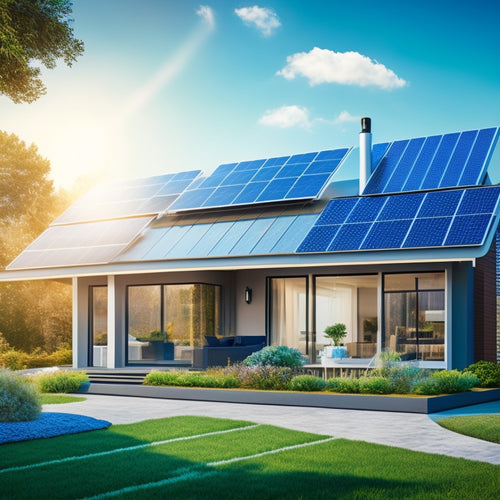
Why Monitor Your Geothermal Heat Pump's Performance?
Share
By actively monitoring your geothermal heat pump's performance, you're taking the first step towards revealing its full potential, guaranteeing maximum energy efficiency, and prolonging its lifespan. You'll identify opportunities to optimize energy consumption, detect potential issues before they escalate, and extend the system's lifespan by reducing wear and tear on components. Regular monitoring also helps you reduce maintenance costs, improve system reliability, and enhance home comfort levels. By staying on top of your system's performance, you'll not only save money and energy but also affirm warranty compliance. And as you investigate your system's data, you'll uncover even more ways to fine-tune its performance.
Key Takeaways
- Monitoring your geothermal heat pump's performance optimizes energy efficiency, identifies potential issues early, and extends system lifespan.
- Regular tracking of energy consumption and production enables fine-tuning for maximum energy savings and reduces energy loss.
- Identifying and addressing potential issues early prevents costly repairs, reduces maintenance costs, and improves system reliability.
- Monitoring performance provides precise temperature control, facilitates humidity management, and balances energy consumption with user preferences.
- Regular monitoring is often required for warranty compliance, involving scheduled maintenance, performance data logging, and alert systems for potential issues.
Optimize Energy Efficiency
Optimizing energy efficiency is vital to guarantee the cost-effectiveness and environmental sustainability of geothermal heat pump systems. You can achieve this by tracking your system's performance regularly.
Performance tracking allows you to identify areas of improvement, which can lead to significant energy savings. By monitoring your system's energy consumption and production, you can adjust its operation to enhance its efficiency. This not only reduces your energy bills but also minimizes your carbon footprint.
Additionally, integrating renewable energy sources, such as solar energy, can boost energy self-sufficiency and carbon neutrality. Regular maintenance, including cleaning, is also important for peak energy production, as it can prevent up to 25% energy loss.
With real-time data, you can fine-tune your system to achieve maximum energy savings, ensuring you reap the full benefits of your geothermal heat pump investment. By taking control of your system's performance, you can enjoy the freedom to reduce your energy costs and environmental impact.
Identify Potential Issues Early
You'll want to perform regular system checks to guarantee your geothermal heat pump is operating within ideal parameters.
By doing so, you'll be able to identify potential issues early, such as refrigerant leaks or clogged air filters, before they escalate into more serious problems.
Early detection of energy efficiency drops can also help you take corrective action to prevent energy losses and maintain a high level of system performance.
Implementing load management strategies like energy arbitrage and conducting energy audits can also help enhance energy usage and reduce costs.
System Checks
Regular system checks are essential to identifying potential issues early, preventing unexpected downtime, and guaranteeing your geothermal heat pump system operates at peak efficiency.
By performing routine checks, you can catch potential problems before they escalate into major issues. This includes implementing monitoring systems for key performance indicators to track fuel efficiency and emissions data, and utilizing data-driven decisions to enhance system operations.
- Verifying system calibration to guarantee peak performance
- Reviewing performance metrics to identify trends and anomalies
- Inspecting system components for signs of wear or damage
- Checking refrigerant levels and guaranteeing proper charging
- Validating system settings to ensure they align with your specific needs and climate
Energy Efficiency Drops
A sudden drop in energy efficiency can be a red flag for your geothermal heat pump system, indicating potential issues that need to be addressed promptly. You must identify the root cause of this drop to prevent further energy consumption increases.
Monitoring your system's performance metrics, such as energy consumption and temperature differentials, can help you detect anomalies early on. This is especially vital in light of the growing trend towards renewable energy sources and sustainable practices.
Additionally, it's important to take into account the carbon footprint of your system and investigate ways to minimize its impact. By doing so, you'll be able to pinpoint potential issues, such as faulty sensors, clogged heat exchangers, or refrigerant leaks, and take corrective action before they escalate into major problems.
This proactive approach guarantees your system operates within ideal parameters, maintaining its energy efficiency and saving you money on your utility bills.
Extend System Lifespan
By monitoring your geothermal heat pump's performance, you can reduce wear and tear on system components, preventing premature replacement and costly repairs.
Additionally, optimizing system operations will also help extend the lifespan of your system, much like how advanced battery tech and renewable energy sources electrifying the industry are changing the automotive sector.
Reduce Wear and Tear
Across the operational lifetime of a geothermal heat pump system, mechanical components are subjected to varying levels of stress, which can lead to premature wear and tear.
By monitoring your system's performance, you can reduce wear and tear, extending its lifespan and maintaining its efficiency. This is achieved by:
- Tracking performance metrics, such as flow rates and pressure drops, to identify potential issues before they become major problems
- Adhering to operational guidelines, such as recommended maintenance schedules and fluid quality standards
- Identifying opportunities to optimize system operation, reducing stress on mechanical components
- Implementing corrective actions to address deviations from expected performance
- Adjusting system settings to mitigate the impact of external factors, such as weather patterns or groundwater quality changes
Prevent Premature Replacement
As you strive to maximize your geothermal heat pump system's lifespan, monitoring its performance becomes essential in preventing premature replacement. By tracking performance metrics, you'll identify potential issues before they escalate into major problems.
This proactive approach helps extend your system's lifespan, saving you from the financial burden of early replacement. Monitoring energy consumption patterns also reveals opportunities to optimize system operation and reduce waste.
Optimize System Operations
While your geothermal heat pump system is operating, subtle inefficiencies can creep in, quietly eroding its performance and lifespan.
To enhance system operations and extend its lifespan, you need to keep a close eye on its performance metrics. By monitoring your system, you can identify areas for improvement and make data-driven decisions to improve its operation.
- Adjust system settings to align with current geothermal trends and seasonal changes
- Identify and address air leaks, refrigerant leaks, or other issues that can reduce efficiency
- Clean and maintain heat exchangers to guarantee effective heat transfer
- Confirm proper system sizing and balancing to avoid overworking the system
- Analyze performance data to identify opportunities for improvement and enhance system operation
Reduce Maintenance Costs
About 70% of geothermal heat pump system maintenance costs stem from inefficient system operation, faulty installations, and poor maintenance practices. By monitoring your system's performance, you can identify and address these issues, reducing your maintenance costs. Performance tracking helps you detect potential problems before they escalate into costly repairs.
| Maintenance Cost Savings | Description |
|---|---|
| 30% | Reduced frequency of maintenance calls |
| 25% | Extended equipment lifespan |
| 20% | Lower energy consumption |
| 15% | Fewer replacement parts needed |
| 10% | Reduced labor costs for repairs |
Improve System Reliability
By closely monitoring your geothermal heat pump system's performance, you can pinpoint and correct issues that might otherwise lead to equipment failure, thereby improving system reliability.
This proactive approach enables you to identify potential problems early on, reducing the likelihood of costly repairs or even system replacement.
Performance tracking and system diagnostics are essential tools in maintaining a reliable geothermal heat pump system.
Some key benefits of monitoring your system's performance include:
- Identifying and addressing minor issues before they become major problems
- Reducing the risk of system downtime and associated losses
- Optimizing system performance for maximum efficiency
- Extending the lifespan of your equipment
- Ensuring your system operates safely and within design specifications
Enhance Home Comfort Levels
Frequently, homeowners with geothermal heat pump systems enjoy a consistently comfortable indoor climate, thanks to the system's ability to provide precise temperature control and humidity management.
By monitoring your system's performance, you can fine-tune temperature regulation and humidity control to meet your specific comfort zones. This guarantees ideal air quality and thermal comfort throughout your home.
As seasons change, you can make seasonal adjustments to maintain an ideal indoor climate. Additionally, monitoring allows you to balance energy consumption with your user preferences, minimizing noise levels and maximizing energy efficiency.
With real-time data, you can tailor your system to your needs, securing a perfect energy balance and ultimate freedom to enjoy your home.
Meet Warranty Requirements
Within the geothermal heat pump system's warranty terms, regular monitoring of its performance is often a stipulated requirement.
You need to guarantee warranty compliance by keeping track of your system's performance. This involves maintaining accurate and thorough performance documentation, which can be an intimidating task without a monitoring system in place.
Here are some key aspects of warranty compliance you'll need to take into account:
- Regularly scheduled maintenance and inspections
- Performance data logging and analysis
- Alert systems for potential issues or malfunctions
- Detailed records of repairs and maintenance activities
- Ongoing system optimization and tuning
Frequently Asked Questions
Can I Monitor My Geothermal Heat Pump's Performance Remotely?
You can easily monitor your geothermal heat pump's performance remotely through mobile apps or web portals, granting you remote access to track its efficiency, energy usage, and performance metrics, giving you freedom to optimize its operation from anywhere.
How Often Should I Check My System's Performance Data?
You should check your system's performance data regularly, ideally daily, to guarantee ideal operation, and at least weekly for data interpretation, adjusting the performance frequency as needed to maintain peak efficiency and freedom from energy waste.
What Kind of Data Should I Be Monitoring for Optimal Performance?
You're tracking the right metrics when you monitor temperature fluctuations, flow rates, and pressure drops, guaranteeing your geothermal heat pump operates within ideal ranges; don't forget to log maintenance schedules to prevent issues and make sure your system runs freely and efficiently.
Are There Any Specific Metrics I Should Focus on for Energy Efficiency?
You'll want to focus on key efficiency indicators like coefficient of performance (COP) and energy efficiency ratio (EER) to optimize your geothermal heat pump's energy consumption, comparing them to industry-recognized performance benchmarks for maximum freedom from energy waste.
Can Monitoring Performance Data Help Me Troubleshoot Issues Myself?
You can troubleshoot issues yourself by analyzing performance data, identifying anomalies in key indicators like temperature, flow rates, and pressure, and applying troubleshooting techniques to pinpoint the root cause, enabling you to take control of your system's performance.
Related Posts
-

3 Best Eco-Grants for Home Energy Upgrades
You're eligible for various eco-grants that can help you cut down on energy bills and reduce your carbon footprint by...
-

Why Choose Cool Roofs in Scorching Climates?
You opt for cool roofs in scorching climates because they enable you to reclaim control over your energy consumption ...
-

7 Best Cool Roof Rebates for Energy-Savvy Homeowners
You're an energy-savvy homeowner looking to install a cool roof, and you're wondering which rebates can help you save...


